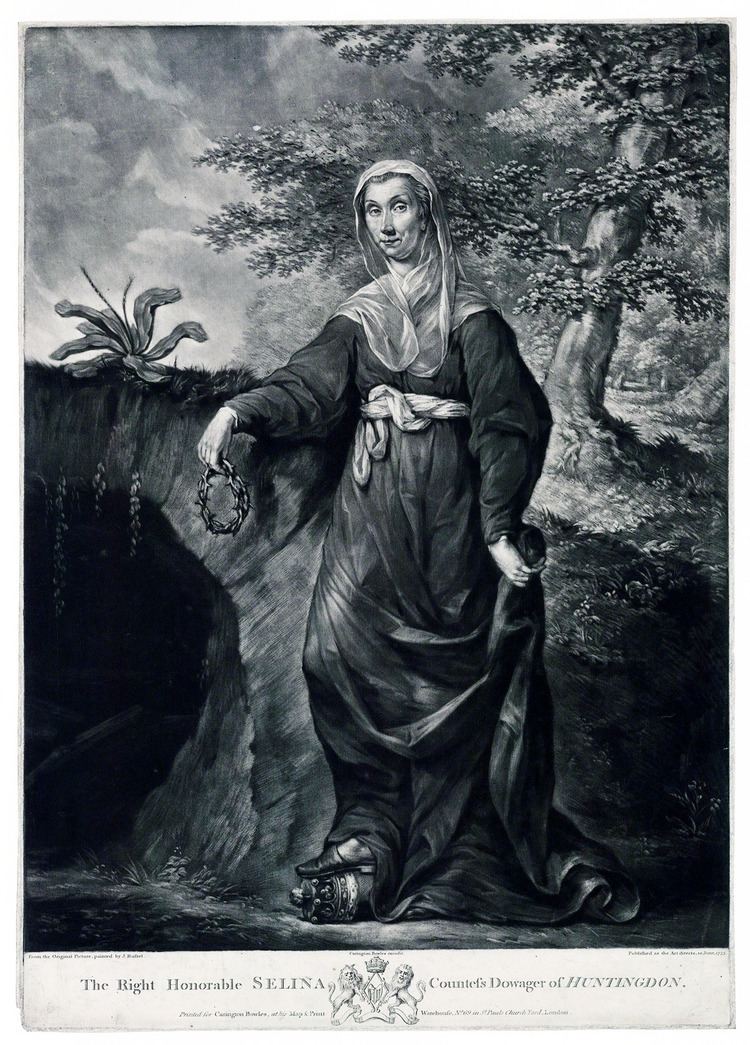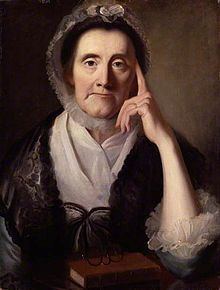Title Countess of Huntingdon Nationality British | Known for Methodism Name Selina Countess | |
 | ||
Born 24 August 1707 ( 1707-08-24 ) Died June 17, 1791, London, United Kingdom Children Francis Hastings, 10th Earl of Huntingdon, Elizabeth Rawdon, Countess of Moira Parents Mary Levinge, Washington Shirley, 2nd Earl Ferrers Grandchildren Francis Rawdon-Hastings, 1st Marquess of Hastings Cousins Laurence Shirley, 4th Earl Ferrers, Robert Shirley, 6th Earl Ferrers, Washington Shirley, 5th Earl Ferrers, Selina Furnese | ||
Selina Hastings, Countess of Huntingdon
Selina, Countess of Huntingdon (24 August 1707 – 17 June 1791) was an English religious leader who played a prominent part in the religious revival of the 18th century and the Methodist movement in England and Wales, and has left a Christian denomination (Countess of Huntingdon's Connexion) in England and in Sierra Leone in Africa.
Contents
- Selina Hastings Countess of Huntingdon
- Early life
- Conversion and husbands resistance
- Religious revival
- Chapel building
- Arrangements after her death
- Family
- References

Early life

Selina Hastings was born Lady Selina Shirley, the second daughter of Washington Shirley, 2nd Earl Ferrers and Mary Levinge, at Staunton Harold, a mansion near Ashby-de-la-Zouch in Leicestershire.
Conversion and husband's resistance
According to the article, Selina Countess of Huntingdon, her conversion experience occurred after a personal bout of a severe illness and becoming bored with her life. Lady Selina gained a saving faith by the influence of her sisters-in-law, Lady Margaret, and Lady Elizabeth. Lady Margaret and Lady Elizabeth were fans of the Oxford Holy Club, the evangelical movement started by John Wesley, Charles Wesley, and George Whitefield.
During the early portion of her faith walk, Lady Selina Countess of Huntingdon's husband sent for an Anglican bishop to restore her to a "saner mind". The learned Bishop tried to woo her from the Methodist leaders but failed miserably. At one point in the persuasive arguments, the bishop expressed his regret about ordaining George Whitefield. In typical Lady Huntingdon style, she gave the following reply to the Anglican leader, 'Mark my words my Lord, when you are upon your dying bed that will be one of the ordinations upon which you will reflect with pleasure'.
Religious revival
In 1739, Lady Huntington joined the first Methodist society in Fetter Lane, London. Some time after the death of her husband in 1746, she threw in her lot with John Wesley and George Whitefield in the work of the great revival. Whitefield became her personal chaplain, and, with his assistance, following problems put in her path by the Anglican clergy from whom she had preferred not to separate, she founded the "Countess of Huntingdon's Connexion", a Calvinistic movement within the Methodist church.
In the earlier part of her life Isaac Watts, Mary, Lady Abney, Philip Doddridge, and Augustus Montague Toplady were among her friends. Lady Anne Erskine (eldest daughter of the 10th Earl of Buchan), was her closest friend and companion for many years in the latter part of Lady Huntingdon's life.
Chapel building
In 1748, the Countess gave Whitefield a scarf as her chaplain, and in that capacity he preached in one of her London houses, in Park Street, Westminster, to audiences that included Chesterfield, Walpole and Bolingbroke. She held large dinner parties at which Whitefield preached to the gathered dignitaries after they had eaten.
Moved to further the religious revival in a Calvinistic manner compatible with Whitefield's work, she was responsible for founding 64 chapels and contributed to the funding of others, insisting they should all subscribe to the doctrines of the Church of England and use only the Book of Common Prayer. Amongst these were chapels at Brighton (1761), Bath (1765), Worcester (c. 1766), Tunbridge Wells (1769), several in Wales, and a small number in London including founding one adjacent to her London home at Spa Fields, Clerkenwell/Finsbury (which resulted in a case being brought before the ecclesiastical courts by the vicar of the parish church of St James). She partly funded the independent Surrey Chapel of Rowland Hill. She appointed ministers to officiate in them, under the impression that as a peeress she had a right to employ as many chaplains as she pleased. In her chapel at Bath (now owned by the Bath Preservation Trust and housing the Building of Bath Collection which is open to the public) there was a curtained recess dubbed "Nicodemus' Corner" where bishops sat incognito to hear services. Following the expulsion of six Methodist students from St Edmund Hall, Oxford in 1768 she founded a ministers' training college at Trefeca near Talgarth, in Mid Wales, not far from Brecon. George Whitefield preached at the opening ceremony. The college moved to Hertfordshire in 1792, and was renamed Cheshunt College. It moved to Cambridge in 1906. The college merged with Westminster College, part of Cambridge University and the training college of the Presbyterian Church of England (and subsequently after 1972 of the United Reformed Church), in 1967. The Presbyterian Church of Wales college at Trevecca is approximately 400m south of the Countess's college (which is now a farmhouse) and derives from the work of Howell Harris. It is said that Lady Huntingdon expended £100,000 in the cause of religion.
A slave owner, having inherited overseas estates, the Countess promoted the writings and independence of formerly enslaved Africans who espoused religious views compatible with her own including authors Ukawsaw Gronniosaw, Phillis Wheatley and Olaudah Equiano. During the mid-1760s, she met and befriended Mohegan preacher Samson Occom, then on a tour of England to raise funds for Indian missions.
Until 1779 Lady Huntingdon and her chaplains were members of the Church of England, but that year the consistorial court prohibited her chaplains from preaching in the Pantheon, in Spa Fields, Clerkenwell which had been rented by the Countess. To evade the injunction she was compelled to take shelter under the Toleration Act placing her among the dissenters, and severed from the Connexion several eminent and useful members, among them William Romaine and Henry Venn.
Arrangements after her death
Until her death in London, Lady Huntingdon exercised an active, and even autocratic, superintendence over her chapels and chaplains. She successfully petitioned George III about the gaiety of Archbishop Cornwallis' establishment, and made a vigorous protest against the anti-Calvinistic minutes of the Wesleyan Conference of 1770, and against relaxing the terms of subscription of 1772.
On the Countess's death in 1791, the 64 chapels and the college were bequeathed to four trustees. Amongst them were Dr Ford, and Lady Ann who was requested to occupy and reside in Lady Huntingdon's house, adjoining Spa Fields Chapel, and carry on all needful correspondence, which was immense. She did this on dutifully until her own death in 1804, and burial at Bunhill Fields.
The principal trustee was the Reverend Thomas Haweis, who presided at the Convocation of the Connexion, comprising about 120 chapels, even though he continued as a Church of England priest as rector of All Saints, Aldwincle, from 1764 until his death in 1820. He made every effort to ensure the Connexion kept as close to the Church of England as was possible. Many chapels became part of the Free Church of England in 1863.
One of the earliest changes under the new trustees was to complete plans to relocate the college. In 1792 it removed to Cheshunt, Hertfordshire where it remained as Cheshunt College, until 1905, when its functions were transferred to Cambridge University. The college was noted for the number of men it sent into foreign missions.
In 1795 Spa Fields Chapel, was used by the founders of the non-denominational Missionary Society, which became the London Missionary Society, for preachers contributing to this, its founding meeting. After her death, much of her movement merged with the Congregationalist Church, who came to predominate in the London Missionary Society, and more joined the Free Church of England in 1863, although there are still 25 Connexion congregations functioning in England, with others in Sierra Leone.
In her will, she requested no biography of her should be written and none was attempted until 90 years after her death. Obituaries and tributes were written: Horace Walpole described her as the patriarchess of the Methodists, whilst the Roman Catholic, John Henry Newman, commented She devoted herself, her means, her time, her thoughts, to the cause of Christ. She did not spend her money on herself; she did not allow the homage paid to her rank to remain with herself. She was clearly a pivotal figure in the Evangelical Revival.
Huntingdon College, in Montgomery, Alabama, is a coeducation liberal arts college named after the Countess of Huntingdon to honour her contributions to Methodism.
Huntingdon Street in Savannah, Georgia, is likewise named after her in recognition of her association with Whitefield and John and Charles Wesley in their apostolic works in the Colony of Georgia.
Family
She married Theophilus Hastings, 9th Earl of Huntingdon, the son of Theophilus Hastings, 7th Earl of Huntingdon and his second wife, Frances Fowler on 3 June 1728. They had six children, three died in childhood and a daughter, Selina, died at the age of 26. Her longest surviving children were:
